The red “Stop the Quarry” signs begin outside the town of Digby, Nova Scotia, and continue all the way down the Neck.
The long southwestern arm of the North Mountain, the Digby Neck is the extension of the worn and forested ridge to the west of the Annapolis Valley, which, including Long and Brier Islands, runs for some sixty kilometres before sinking into the sea after Westport. Just over two kilometres wide, the Neck divides the Bay of Fundy from the more tranquil, sheltered waters of St. Mary’s Bay. The peninsula is like a great wharf reaching into what was once one of Nova Scotia’s most fertile fishing grounds. Whales of all kinds still travel here for Fundy’s cool waters and an easy feed of plankton, northern shrimp, and herring, so that some lobster fishers use their boats for whale-watching tours in the off-season.
Subtle differences in the character of the villages along the Neck have played into an extraordinary dispute that started five years ago now, concerning a mega-quarry that an American-owned company, Bilcon of Nova Scotia, wants to build at Whites Point, outside Little River on the Fundy shore. Sandy Cove, a village at the Neck’s narrow midway point, is a salubrious place where many Canadians from out of province visit or—as my wife and I do—keep a summer home. American families also come here, many able to trace their ties to the days before the modern nation existed, when land grants were accorded to United Empire Loyalists. The area was once home to summer camps, inns, and a schoolhouse, and still boasts handsome white houses and churches that nestle around Sandy Cove’s protected wharf, on St. Mary’s Bay, and on the short road over the ridge to the village’s Fundy side and the only sandy beach on the peninsula. In summer, brave children jump off the wharf into Fundy’s freezing water, as others lie on the sand by Jerome’s Rock, named after the sailor who, in 1863, was washed ashore, unable to speak, with his legs amputated above the knees. Few want the quarry here.
Centreville, a little farther north, conjures a darker mood. Perhaps this is because Little Arthur, a bootlegger, used to sell liquor here to men who could not afford the trip to Digby, or to fishers who wanted a drink on Sunday. Or perhaps it is because Centreville is home to the Johnsons, one of two families from North Carolina who made the Little River purchase with a view to building the quarry in the first place. Or maybe it’s because Randy and Cindy Nesbitt, the decent, hard-working couple who run Wilson’s on the Neck, a gas station and dry goods store, wore those Bilcon of Nova Scotia baseball caps and even erected a great big billboard saying A Step Forward: Start the Quarry.
If Sandy Cove is a community Bilcon could not penetrate and Centreville is the company’s unofficial seat, then Little River, about three-quarters of the way down the Neck, is where the battle for the pockets and minds of locals has been most divisively fought. Like Sandy Cove, the village is a picture-postcard-perfect community of white clapboard homes dating back to the arrival of the Loyalists, and newer ones belonging to prosperous fishers who stack their hundreds of lobster traps along their asphalt driveways in the off-season. At the junction with the 217, there is a Baptist church, a small post office, and a whale-watching kiosk. Travel the east road along to the wharf, and you will pass a series of fishers’ sheds, warehouses, and a lobster pound. Take the road to the lookout on the western side, and you will feel colder, stronger breezes and see the boats that work the Bay of Fundy—the lobster fishing season here starting in November and working through the bitter, surf-whipping storms of winter. You will be standing on a bluff made of basalt and looking across ocean pathways over which, nearly four centuries ago, Virginian colonists travelled in order to plunder Champlain’s original Annapolis habitation. These two factors—the abundance of basalt here and its proximity to deep water—have pitted neighbour against neighbour, father against son, and have brought the region to the precipice of a radically different tomorrow.

Bilcon of Nova Scotia is the fully owned Canadian arm of Clayton Concrete Block and Sand, a large New Jersey–based aggregate producer also known as Clayton Block. It is impatiently waiting to begin construction on what could eventually be one of the largest quarries in Canada. Its plan is to blast the approximately 150 hectares of land it owns at Whites Point to as low as ten metres above sea level, then load the crushed basalt onto container ships for transport to New Jersey and eventual use from Massachusetts to Florida. The 40,000 tons of aggregate Bilcon plans to export each week is more than any quarry on the Neck produces in a year, and will dramatically alter the appearance and ecosystem of this delicate, environmentally sensitive region. Quarries already exist on the Neck, but it is the scale of Bilcon’s project and the permission it gives to other companies that many residents of the Neck and the Annapolis Valley legitimately fear. In the absence of any local zoning laws or a provincial coastal management policy, there is nothing to stop Clayton Block—or any other company in its wake—from exploiting the North Mountain in its entirety. Applications have already been made for other quarries, at Upper Granville, and Victoria Beach, nearer Annapolis.
Founded in 1951, Clayton Block is the largest producer of concrete and crushed stone in New Jersey. It employs 850 people and is one of the last such companies in the state to be family owned and operated. But in the past decade, mergers have led to a situation in which Clayton Block now competes with consolidated companies that control 90 percent of the lucrative New York City market, and also supply much of the 1.5 million tons of aggregate it requires to meet its own manufacturing needs. This, and other exigencies of economic globalization, has put considerable pressure on Clayton Block to find its own secure source of aggregate. Markets for aggregate tend to be close to the source, as the single highest cost is often truck transport to the cities, highways, and building sites where their product is required. So when Mark Lowe, a Canadian from Nova Scotia, approached the Claytons with information about a huge amount of high-quality basalt that could be shipped annually by sea—ocean transport reduces the cost of aggregate dramatically—the family was very, very interested.
“This is a business for profit, which is not a dirty word in here,” said Bill Clayton Jr. We met in the boardroom of his company’s offices in Lakewood, New Jersey, in July 2007, ten days after the public hearings in Digby for the project had ended.
The Claytons’ involvement in the quarry began in 2002; five years on, the project still had not been approved. The public hearings were the culmination of a joint federal-provincial environmental review, and the panel’s report was to be submitted in mid-October. Pending its conclusions, the provincial and federal governments would deliver the necessary permits—or not. The New Jersey family was waiting. Testily.
“Your government talks about being ‘open for business,’ and we believed that,” said Bill Jr. “We go there, we’re told by the departments that work these things that they’re very interested in mining, they’re very interested in business, and that in fact mining is an allowed use in the area.” Clearly, the man was pissed off.
“Which department are you talking about? ” I asked.
“Natural Resources,” Bill Jr. said. His father was also at the table and nodded his agreement from time to time. So was John Wall, a quarry manager with no quarry to manage yet. Wall, a strong, stocky man with a barrel chest, was anxious for the project to start. Only now a bunch of upper-class dilettantes was getting in the way, obstructing a quarry that had the chance to be massively profitable and modern. “State of the art,” said Wall.
“When you’re a visiting geologist [in Nova Scotia], the government puts you in a helicopter and shows you potential sites. Try to get that in New Jersey,” he said. “They might take you up in a helicopter and push you out.”
Bill Jr. laughed at his own joke, but his sense of betrayal was evident. Nova Scotia’s Department of Natural Resources advertises a “One Window Process,” in which it hastens investment by arranging for representatives of the relevant government departments—primarily Natural Resources, Environment and Labour, Fisheries and Oceans, and Transportation—to be present and see the issues resolved, only now the window had been muddied, and the view on the horizon was unclear. Still, Bill Jr.’s bearing was that of a pugilist ready, even eager, for the fight’s deciding rounds.
“The opponents are allowed to say anything,” he said. “The most outrageous statement, accusation, lie gets in the paper and is accepted as being fact…I mean, I’ve heard everything: the employees are going to be American; they’re going to impregnate all the women on the Neck and then leave behind the war babies and the war brides.”
“ I really believe that the greatest opposition is from [Americans] who are there two months a year,” added Bill Sr.
Quarrying is not a pretty business, I said, then asked if they were used to resistance.
“What we do is heavy industrial mining, and we go through this every time we want to open,” Bill Jr. said. “Down here, typically, you have to place things where they are zoned to be placed, which is what we thought we were doing…New Jersey is probably the second-toughest state in the country to operate a business in, certainly one of the toughest states to operate mines in. This is an extremely environmental state…it’s much more difficult to operate a business here than anyplace in Canada.”
When I asked if being a quarry company with a guaranteed supply of 2 million tons of basalt a year might make them an attractive takeover target, Bill Jr. shrugged. “I’m not going to say it won’t,” he said. Then I asked the Claytons how they would feel if they were to find themselves in the vicinity of such a controversial project.
“It wouldn’t happen,” Bill Sr. said. “The history here has been that there’s no new quarries open since ’65.”
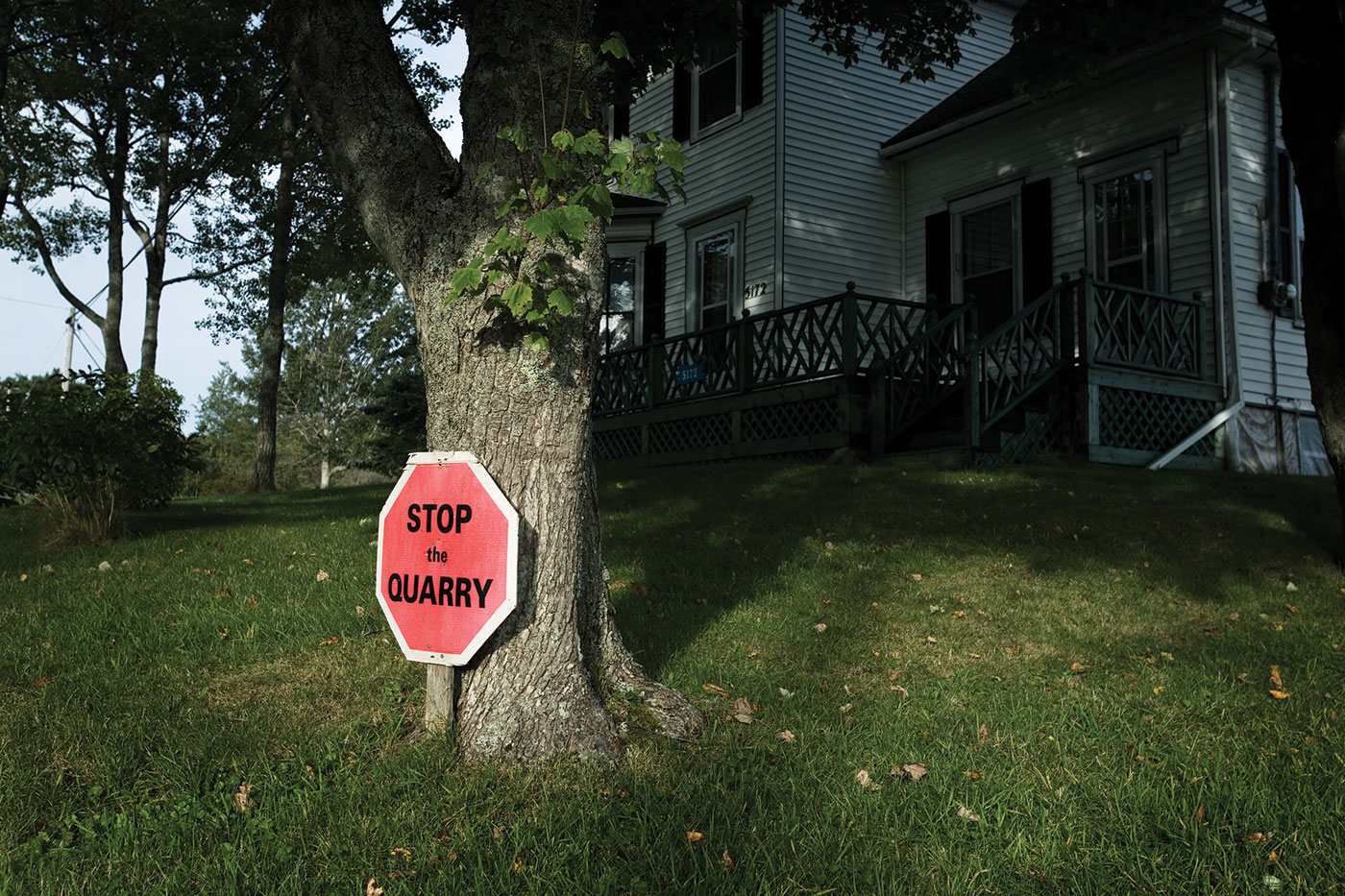
The storm over the Whites Point Quarry and Marine Terminal—a project its American owners evidently know New Jersey would not tolerate—started in April 2002, when the Towle family of Little River noticed a drilling rig heaving its way up a seldom-used road that led behind their house and over the ridge to an unremarkable cove on the Bay of Fundy. There had been an attempt to start a quarry at Eastern Head, on the St. Mary’s Bay side of the Neck, about fifteen years before, and so the incident had the ring of déjà vu, and consternation spread quickly.
Inquiries to the Department of the Environment revealed that a permit had been issued to Nova Stone Exporters, the first incarnation of a shell company that became Global Quarry Products, then Bilcon of Nova Scotia. The permit was for a quarry of less than 3.9 hectares—the ceiling below which no environmental review is required. David Morse, the provincial minister of natural resources, professed that his hands were therefore tied, doing nothing to placate alarmed residents. “He’s issued a permit out of one side of his mouth and is denying it with the other,” said Tony Kelly, then the principal of the Digby Neck Consolidated School at Sandy Cove, who had formed the Committee of Concerned Citizens after learning the true extent of the quarry from a press release received at the school. The release directed inquiries to Russ Patterson, ceo of Patterson Exploration Services, the North Carolina company that was doing the drilling, and announced the intent of “a Nova Scotia aggregate exporting company” to create a 150-hectare quarry and adjacent marine terminal. The worrying information was inadvertently confirmed when Gordon Balser, the local Conservative mla, told Kemp Stanton, a Whale Cove lobster fisher, “We weren’t getting no money to fix our wharf, because we could fish from the wharf that was being put in for the quarry.”
Following such revelations, a coalition called the Partnership for Sustainable Development of Digby Neck and Islands organized a series of chowder supper fundraisers, and a campaign of emails, letters, newspaper articles, bumper stickers, and, above all, highly visible Stop the Quarry signs, which quickly appeared along the length of the peninsula. The ensuing battle pitted a remarkable collection of fishers, townspeople and villagers, year-round and summer residents, old and young, Acadians from the French Shore, as well as citizens of the Neck and the Valley, against Clayton Block and its Canadian front men: Mark Lowe, who was forced out by the spring of 2004; Paul Buxton, an English expatriate engineer from Deep Brook who had been involved in a number of government-subsidized restoration schemes in Annapolis and Bear River; and Gordon Balser, who urged his constituents to give the idea of the quarry a chance, and assured them the project could be halted if that decision was deemed best for the community. David Morse persisted in characterizing the quarry as a municipal matter and declared that all his department could do was see that regulations were followed.
And yet, in November 2002, the Municipality of Digby voted against the quarry, and 1,200 people, including more than 700 of the approximately 1,100 permanent residents of the Neck, signed a petition that was presented to the Nova Scotia legislature. The Digby vote and the petition were ignored by Balser and the province’s Department of the Environment. Said Ian Thurber, an Annapolis County resident involved in the movement, “It’s almost turning into a fight for democracy now.” Balser, nicknamed Gordon Basalter by then, continued, like Morse, to adopt a stance of judicious impartiality, even as his assistant, Kristy Herron, was busy generating resumés for potential applicants. “The day I stop helping people find jobs,” said Herron, “is the day I walk off this job.” Six months later, she did just that—joining Paul Buxton at Global Quarry Products as the company’s communications officer.
Neither was the region’s federal representative much help. Robert Thibault, the Digby-born Liberal MP for West Nova, also the minister for fisheries and oceans, was similarly mute. But then, in January 2003, the application for a deepwater marine terminal was finally made; that June, Thibault wrote David Anderson, the federal minister of the environment, requesting an environmental review.
Two months later, during the August 2003 provincial election, explicitly fought over the quarry in this riding, Balser lost his seat to Harold “Junior” Theriault, a popular former lobster fisher who had repeatedly come out against the quarry. Not one to prevaricate, Theriault never pretended that an aggregate company with access to 150 hectares only intended to mine four. The following year, Thibault, no longer the minister of fisheries and oceans, was vying for re-election, and he finally voiced his concerns about the quarry’s “inappropriate development,” promising to oppose it at the impending public hearings. In November 2004, a panel of three experts—Robert Fournier, Jill Grant, and Gunter Muecke—was appointed to a joint federal-provincial environmental review; over two and a half years later, in June 2007, the two weeks of public hearings finally took place.
The panel heard presentations from the proponent’s team; ten provincial and federal government departments weighed in, as did local municipal groups and political parties, more than a dozen NGOs, and more than forty private citizens. Objections to the quarry included concerns that the lobster and scallop fishery, the region’s lifeblood, would be fundamentally damaged (not least by ballast water containing invasive species); that whales—specifically the endangered right whale—would be killed or injured by an increase in marine traffic; and that local flora and fauna (humans, most of all) would be adversely affected by the noise, dust, augmented road traffic, and prospect of diminished groundwater in an area where dry wells are a constant anxiety. Astonishment was also expressed that no royalty whatsoever would be payable to the province, as basalt is not classified as a mineral. Most important, the project’s critics argued that the quarry would actually subvert more jobs than it would create. The sixty jobs announced by Patterson Exploration were reduced by Gordon Balser to fifty. By the time of the public hearings, they had become Bilcon’s “thirty-four.”
From Digby to Yarmouth, there are 968 lobster licences, with each boat employing roughly four people. In 2006, the lobster fishery in this area accounted for approximately $300 million in revenue. Tourism in Digby County accounted for another $37 million and roughly 1,000 jobs. By Robert Thibault’s own calculations, the ten lobster licences in the immediate vicinity of Whites Point alone account for thirty-five jobs. This figure does not include others harvesting sea urchins, herring, and groundfish, and still others working in whale-watching. Nor does it address the issue of what local jobs the quarry might destroy or prevent from being created.
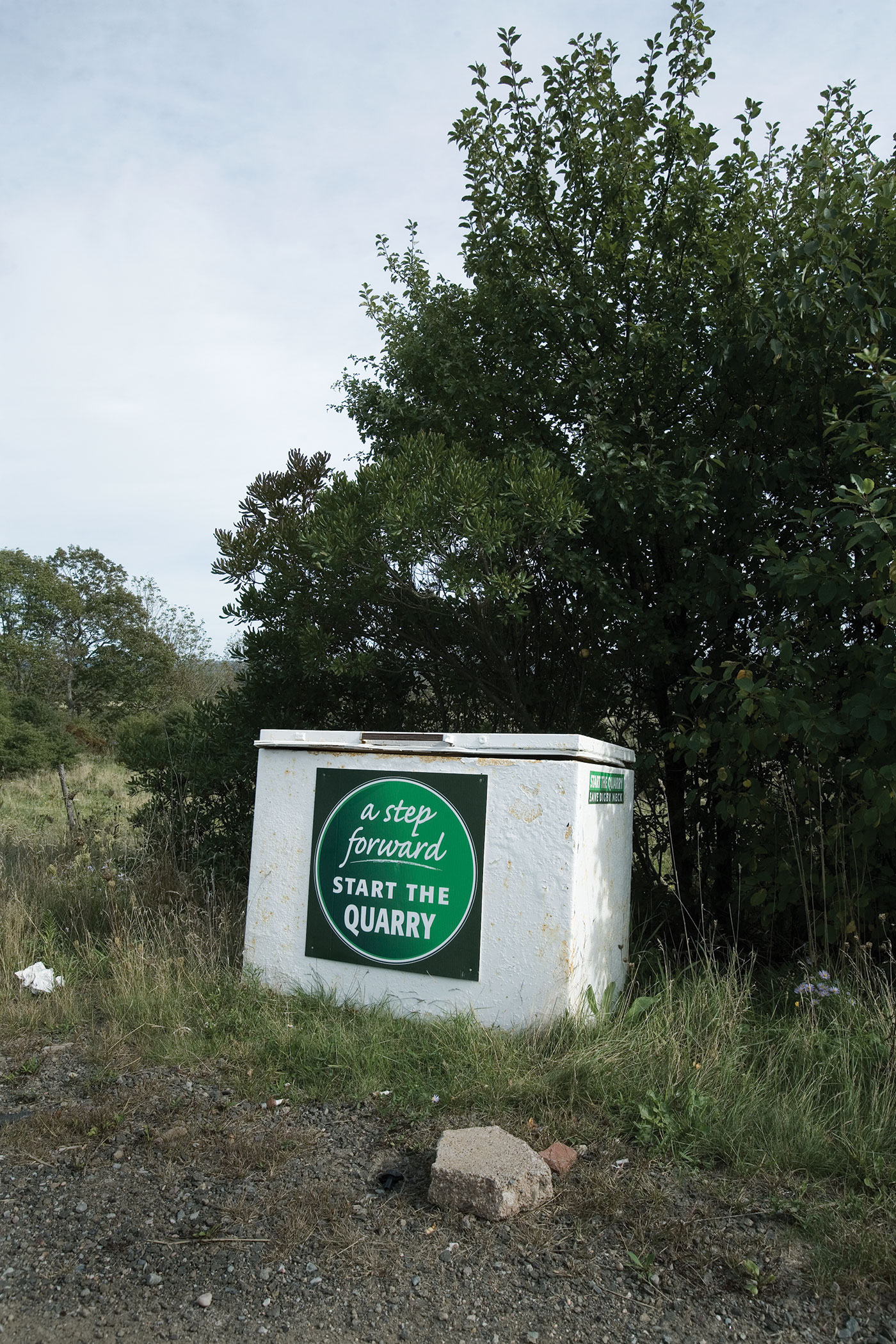
Global issues that are abstract in the cities and settled at a distance are heartfelt and deeply personal in rural areas, where overwhelming and inexorable forces visit themselves upon some unexpecting corner with remarkable intensity—and are acted out and eventually resolved at the level of village affections, enmity, and gossip. Ostensibly local, an argument concerning the destiny of a hitherto unremarkable cove of worn basalt and the few lobster fishers who set their traps close to it quickly showed itself to be a universal story about globalization and its effects on regional authority, the struggle between cities and the countryside, and the trade-off between the environment and jobs. Most of all, it became a drama about community—about who’s in charge. If the community in question consisted of the residents of the Neck, its will—expressed in a petition, then in the second plebiscite of an ousted mla—had been denied. The message being relayed was that the Digby Neck exists only in relation to the greater economies and needs of the province, the country, or the megalopolises of the northeastern US seaboard.
There is, however, the nagging sense on the Neck that globalization has already altered the place, perhaps beyond reckoning.
Today, three-quarter-ton pickup trucks barrel up and down the 217 on their way to the big box stores that have replaced old village shops. At these anaesthetizing places, there are jobs at the cash or on the shop floor for wives and children who used to band lobsters, bait traps, or fillet their husbands’ or fathers’ catches. Although the scallop and lobster harvests are remunerative, there is no inshore ground fishery to speak of anymore, and the ocean draggers are having a harder and harder time of it. There are some conservation measures—the rotation of harvested areas, a minimum size for lobsters, and the jettisoning of females—but the stocks of scallop and lobster are being depleted, and boats need to travel farther or work other fishers’ grounds, and the people know it. You don’t have to read the schooner captains’ logs or peruse the old photographs of the flakes and fish plants along the Neck to see that fish were once plentiful and large; you can speak to residents in their forties who remember how easy fishing for cod, pollock, haddock, and mackerel was at the end of the wharves in Digby, Sandy Cove, and Little River. There was even tuna in the Bay then.
Fishing, not just here but all over the world, is conducted as a kind of mining, not farming, and as a result more and more of it is a dead concern. The connection to be made between the depletion of stocks and overfishing—of the destructive practices of the draggers that are still permitted to wreck seabeds and the breeding habitats of countless species as fishers clumsily, wantonly haul in their catches, or of the New Brunswick seiners that draw nets in a circle and suck out the herring that draw the bigger fish and sea mammals to the Bay—is simply not made, because it requires acknowledging, alongside the Department of Fisheries and Oceans’ notoriously ineffective (and unenforceable) management, that fishers’ practices have played their part in the region’s economic crisis.
Today the fishery is prospering in terms of the overall value of its catch, but it is trawling well down the food chain and employing fewer people than it ever did. And whether you live in Digby, Little River, or Westport, if you’re not one of the lucky ones working at the fish plant or driving a truck for D. B. Kenney Fisheries, if you don’t have the several hundreds of thousands of dollars required to buy a lobster or scallop dragger’s licence, if you’re not making a couple of hundred bucks a (long) day baiting traps on somebody else’s boat, then you are left out, and your kid will likely end up on ferry rides to Digby to work at Sobeys, the Atlantic Superstore, or Wal-Mart, or hitchhiking to Alberta, or depending on uic and welfare—or, worse, crime.
Last winter in Sandy Cove, there was a spate of robberies in which burglars wrested copper radiator pipes from unattended summer homes and caused thousands of dollars of damage for a meagre few hundred dollars’ return. In Digby, during the summer, I had lunch at the Hungry Hollow, a now-closed café (so often the story). The rcmp entered, and Tara, the owner, complained that the same local kids had broken into her restaurant three times. One of them had subsequently applied for a job—it would have been funny were the situation not also serious. In September, a fifty-five-year-old named Wayne Doucette was assaulted by a youth with a gun. Robbery was the motive. The next night, a seventeen-year-old girl and two brothers tied the same man to a chair in his Plymouth home and beat him to death with a baseball bat.
The sorry truth of decades of overfishing is that almost no one on the Neck really believes there will be a healthy fishery in the region in twenty years—and that rock-bottom schemes such as the quarry at Whites Point are being entertained as a result.
“To have this turned into a gravel pit for the United States, it just blows me away,” said an impassioned Harold Theriault at his constituency office. “There’s basalt rock in Maine, there’s basalt rock in Massachusetts, but they can’t touch it. So they’re coming here. It’s easy to get and cheap to get. We took from the ground fishery just like [the quarry] will take from our land. We didn’t think fish could come to an end, but they did, because we just took, took, took. We’ve got to bring our fishery back, and manage it in a way where we can sustain those communities again. Sustainable jobs are going to come from producing tidal power, and wind-generated electricity from the Bay of Fundy, and we won’t be doing that by giving the Neck away.”
In Little River, I waited for Paul Buxton at what used to be the Towles’ house. It was early spring, and Stop the Quarry signs were still in abundance in this hamlet, where others along the Neck had faded. Behind the house Bilcon had purchased in 2005—upsetting many locals, as the intrusion appeared so brazen—Stop the Quarry was spray-painted on a storm drain at the foot of the gravel road leading over the ridge to Whites Point. On the front lawn, Buxton had erected a large Bilcon sign, but only the billboard’s stump footings remained. The sign had been vandalized twice, so he had temporarily removed it.
Buxton arrived in a beige pickup truck. A big man with a white beard and a ruddy, pockmarked face, he wore a Tilley hat and spoke with an English accent. “I don’t know how far we’ll be able to get,” he said. “There’s been a lot of rain, and the road may be too soft.”
The road climbed gently. The top of the ridge had been cleared, and on the other side of it we walked along a sodden path to a clearing above the point. About 100 metres out from shore, three lobster boats were tending their traps, exactly where the terminal would be built to load the freighters and ship the basalt out. Buxton reacted angrily as we passed boulders onto which locals had painted white crosses, signifying the possibility of pioneer gravesites. (The company, insisting none existed, had launched a bullying “slapsuit” against the Little River grandmother who originally suggested as much.) He dismissed the anti-quarry movement’s anxieties, then, in a sombre manner, put forward his own.
“I have grave concerns about rural Nova Scotia,” he said. “We are losing population to the extent that our services are going to diminish—schools, hospitals, ferry services, perhaps—and I believe that unless family-sustaining jobs are provided around here, that this trend will be irrevocable. We can’t survive with minimum wage jobs here. The groundfish are not here. The scallop has been very poor recently, and the fleet has been largely tied up. The lobster industry is typically cyclical, so that we’re going through a very good period at the moment, and let’s hope that it continues that way—but if it does not, what happens to the area economically? ”
Earlier, in Bilcon’s Digby office, Buxton had urged me to read Anthony Davis’s study of declining fisheries, Dire Straits, though he couldn’t find a copy, as he had handed all of his out. Piled on a desk by the door were sheets advertising hourly rates for different jobs, and copies of a spurious letter, purporting to be anonymous, in support of the quarry. What Buxton and his confederates knew was that approval for the quarry would be much more likely if they were able to portray Bilcon as the champion of downtrodden locals’ right to work, and the project’s opponents as a mostly patrician class of summer residents and retirees draining a diminishing local tax base. The strategy was effective, for what bona fide argument can legitimately be made against the wealth even thirty-odd jobs would bring?
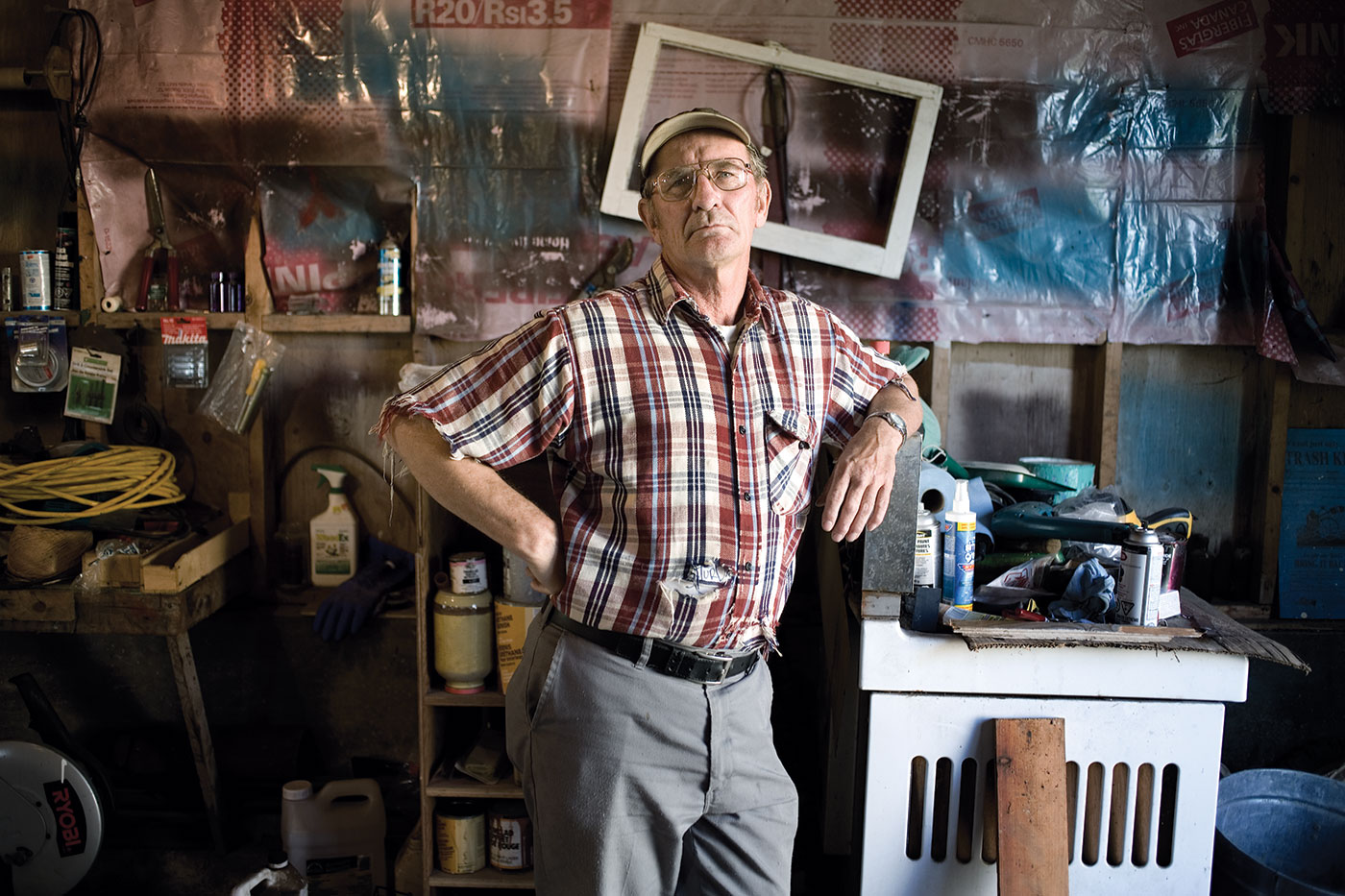
The problems of the Digby Neck are those of rural areas countrywide, as workers and their families—and, most of all, youth wanting what they believe to be a more interesting and exciting life—leave parts of the country where the mechanization of farming, the decline of fishing, or the diminution of other extractive industries has dramatically reduced the number of available jobs, while the car and big box stores have radically altered the nature of retail. Who needs local shops anymore? Who needs local anything? The psychological load is heavy, the situation of Digby and the Neck that of Canada in miniature: hewers of wood, drawers of water, and now, quite possibly, blasters of rock.
There is little of the pride here that comes from the manufacture of things, or from merely showing the place off—with the sort of branding prevalent elsewhere around the Bay, as in the “Maine” lobster (much of which originates in Nova Scotia), or New Brunswick’s “Fundy Trail,” or “Bay of Fundy salmon.” Digby is a gem, but locals don’t always seem to know it, mostly because the economy isn’t telling them so. Sarah Haliburton is the owner of Bluefin Pottery and Hand Creations on Water Street and regularly convenes with the town council’s tourism committee. “People don’t know why anyone would want to come here,” said Haliburton. “It’s a hard fight.”
Sustenance here has always been achieved by taking things—from the sea and forest and the land itself—and the worker gives away a little piece of himself each time he takes from them. The hills and forests of the peninsula, rugged and beguiling as it peels away in a series of receding coves, the high tides revealing muddy russet flats and the high red bluffs at Rossway remain the casualties of a community that is still essentially maritime and too hard working to be thinking of conservation much. There are no managed trails on the Neck at all, even though the one that leads to the Balancing Rock on Long Island—a column made of basalt—is one of the region’s main tourist attractions. Aside from the whale-watching outfits, no entrepreneurs offer, say, bicycle, kayak, scuba diving, or sailboat tours. Only now, possibly too late, is there the sense that something must be done about what Michael Corbett, a local sociologist, has described as the “economic potential in the natural beauty of the area.” Many of the quarry’s proponents, among them Harold Rowe, have been arguing for as much, knowing, beyond any arguments about jobs lost as others are gained, that the only truly incontestable response to a corporation promising thirty-four jobs is to prove that other kinds of development augur more.
But conservation and sustainability, the pillars on which ecotourism rests, are only recent imperatives along the Neck, where extraction, its nemesis, is still widely regarded as a right. Here, a person buys a wood-burning stove knowing that a lot of cheap land provides fuel and takes him off the grid—that the wood is money not spent. In the battle of the classes as it may exist on the Neck, the worker is the one with the atv and the Tim Hortons cup. The land here is his to roam, the sea his to exploit, the gas his to burn, the timber his to fell, the trash his to dump off the end of the wharf, because the alternative is to have to wait for government pickup and be charged for it. Conservation here is considered an imposed, gentrified idea that means a lesser haul of fish, and therefore less income and more that other boats, provinces, or countries can subsequently take. It is in the nature of fishing to grab what you can—take everything allowed and plumb the rich seam.
In the summer of 2007, fishers working in the off-season were trawling for dogfish, a part of the catch once considered a nuisance. Now the going rate is sixteen cents a pound for a permitted weekly haul of 10,000 pounds, averaging out to $1,600 a week for work that requires a couple of paid crew, a boat, and gasoline, the sum of which will be taxed. The prospect of a bit of stolen copper pipe starts to look attractive.
“The quarry is supported by people who are desperate,” said Laurence Outhouse, a retired engineer from Tiverton. “It’s about people who have lost all hope.”
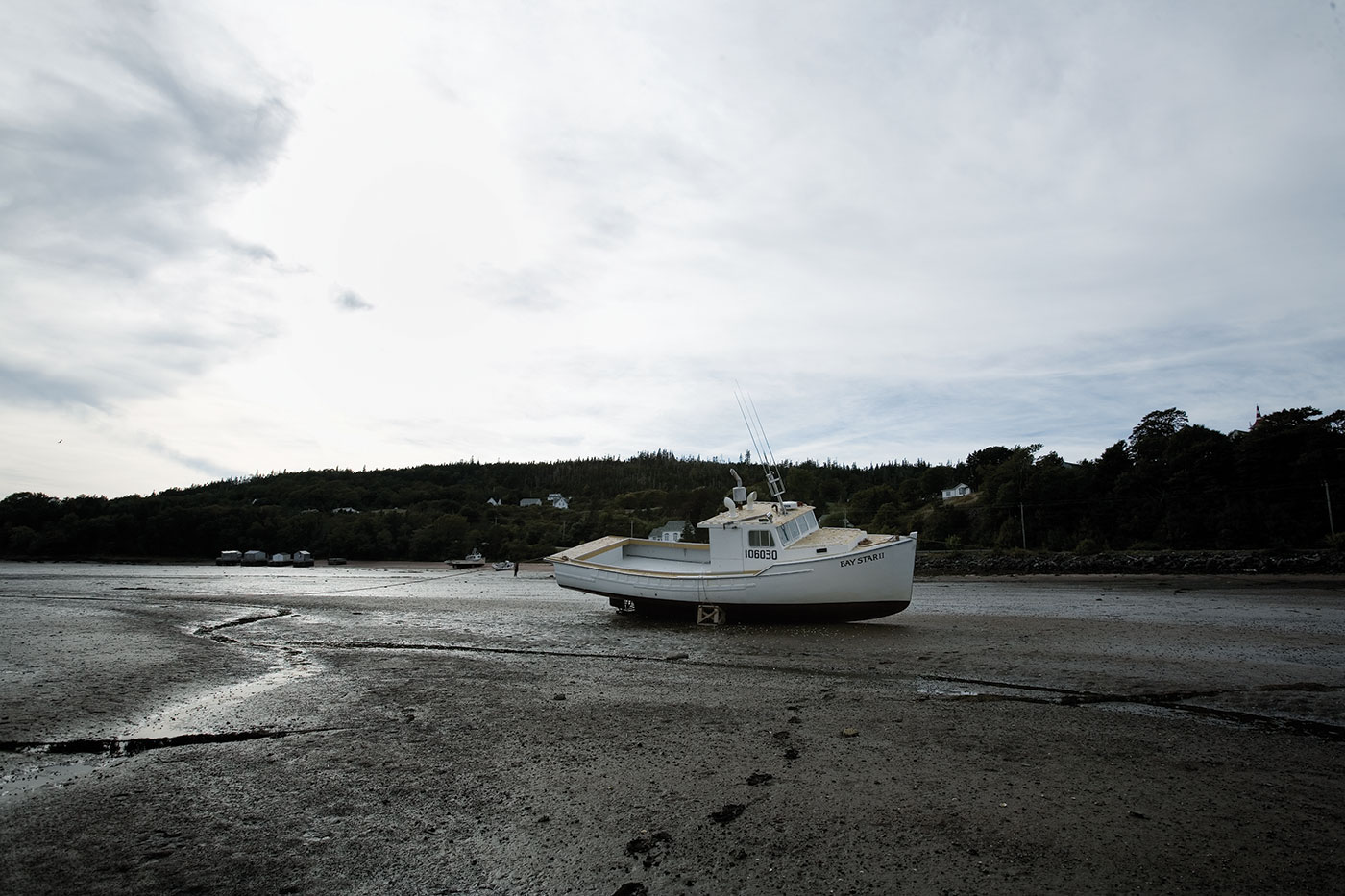
By the end of the fourth year, the Stop the Quarry movement was beginning to tire. The domino effect of land sales around Little River had come to pass, and the quarry’s opponents were being painted as part of the problem, rather than concerned with the best economic future for the Neck. The signs and billboards Bilcon aggressively provided, some of them appearing on the lawns of absentee landlords, read A Step Forward: Start the Quarry, and Start the Quarry, Save Digby Neck, against a sly background wash of the requisite pro-environmental green. Despite the distrust that had initially prevailed, it appeared that Buxton and his colleagues had succeeded in making the idea of the quarry a cause.
The issue of the quarry was clad in the costume of class conflict, but it remained, at its core, about the power of a community to define and defend itself. During the public hearings, issues concerning the environment were used by both sides to defend the physical integrity of the Neck and the Bay, but also to wage the battle about community by proxy. The environmental concerns tabled, covering everything from the spawning habits of lobsters to the effect of increased nitrogen in quarry runoff, were, on the one hand, about the species themselves, but on the other about the impassioned, desperate measures of locals wanting to wrest some of the power away from governments and corporations and put it back into their own lives.
Bilcon, too, was aware of the clarion call of the times, its bit of bad timing that green anxiety was raging as its environmental impact statement was being prepared. So it used, wherever it could, the green lexicon. In the statement, which was sent back for more information, then during the hearings, the quarry repeatedly described by Bilcon and its phalanx of consultants as a model of sustainable development when it is no such thing. The rock, a surprisingly exigent panel pointed out, existed in massive but finite quantities. No pushover, the panel called them on this point and—concerning measures that might be necessary in the face of rising sea levels and other vagaries of climate change—on its frequent but unsubstantiated use of the term “adaptive management.”
Most illuminating was the moment when, on day two, responding to a question about the stress the quarry posed to endangered flora, Ruth Newell, representing Bilcon, replied that “a lot of stresses are on them already, and they are probably all ready to cope with some stress or perhaps extra stress.” It was another way of saying that the humans on the Neck, unemployed and impecunious, could suffer the kind of stress that whatever untoward effects the quarry might engender because they, too, were under “a lot of stresses” already: low employment, poor services, crime, out-migration, and so on.
This patronizing, insulting inference appears in a variety of guises throughout the tens of thousands of pages of documentation Bilcon submitted to the panel leading up to the hearings. In its “Valued Environmental Component Impact Summary,” the mining and exporting of 2 million tons of rock a year for fifty years is described as being without “significant negative aspects” in seventy-six measures covering air quality, noise, land contaminants, human health, heritage, tourism, land value, social relations, and aesthetics, among others. Remarkable, really, given that the environment in question would be almost entirely removed.
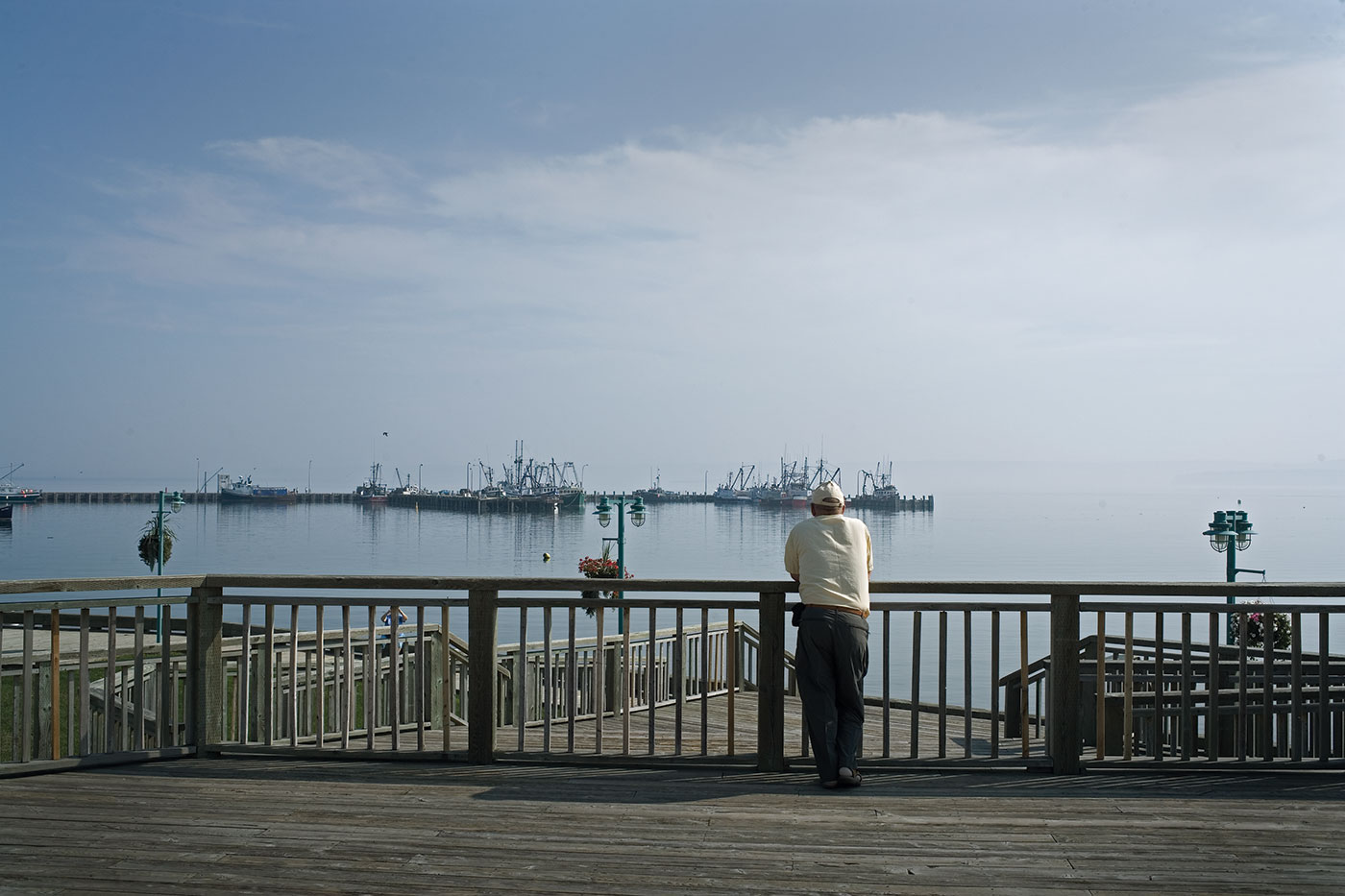
In the battle being fought about the nature of home, the speaker Bilcon authentically feared, the man who had been such an unexpected impediment to the company’s advance, was Kemp Stanton, a seventh-generation lobster fisher who lives in Whale Cove.
“K-e-m-p,” the fisher said, distinguishing himself by spelling out his first name, after everyone else had spelled their last. Since 2002, Kemp had put the views of concerned residents who still draw their living from the sea so articulately that he became chair of the Sustainable Development of the Digby Neck and Islands Society and the lyrical popular voice of the anti-quarry movement. He could not be assailed as elitist or “come from away,” without knowledge, or as someone not contributing to the economy and society’s coffers.
Kemp’s family had been fishing off the Neck for 275 years. He’d wanted to be an archaeologist, but remembered how his teachers had treated him as a fisherman and made him feel stupid. More than forty years later, he was aware of the irony of academics and bureaucrats, at the seminars to which he now found himself invited, crediting him with “traditional knowledge”—as if it was theirs to give. What Kemp had been saying for five long years was that a life, no matter how small a statistic it might seem to government, to universities, or to a foreign corporation, is significant, does suffer “adverse” effects.
I asked him if, given the long history of the fishery’s decline, residents should be more accepting of the few jobs the quarry might bring. “No,” he replied. He spoke haltingly but with great emotion—as one who’d not been called upon to speak publicly until recently, and who was not quite used to the authority of his own voice. “I’ve been accepting of a lot of things all my life,” he said, “and I’m ashamed as hell of it. Forty-three, forty-four years ago, when I started out, Jesus, the Bay was full of life. Some days, you’d go to shore, and you’d have to talk really loud because there were so damn many gulls hollering, picking stuff out of the water…Everywhere you’d look, there was something going through the water. It was alive.
“Now it’s like a museum piece: the Bay’s still there, it’s on display, but it’s dead. And that’s happened during my lifetime—and I allowed it to happen. And I didn’t participate. I thought I was smart, and I said I wouldn’t go aboard a dragger when it was away from the wharf. I never went aboard a seiner, and I’ve never done anything in the fishery that I was really ashamed of…I thought I was being smart and good, but I’ve never done anything to stop anybody else. And if this quarry is going to help finish off what little life is left in the Bay of Fundy, goddamn, I’m not going to let them do it. I let them kill most of the stuff off, and I let the experts”—he sighed—“dictate to me, and make me believe that I was stupid, and make all these predictions, and I found out I’m a hell of a lot more ‘expert’ than they are. For all the damage I’ve allowed to happen during my generation—damn, I’ve got to do something before I die to help put back a little bit. I’ve lived good, and my family’s lived good out of that Bay. And we owe it to—well, most people would call it the planet, but it’s the Bay to us.”
In Halifax, a highly placed source at Nova Scotia Environment and Labour told me that the quarry issue would be settled strictly on the basis of environmental concerns. The province has often stated its intent to be a net exporter of environmental technology (tidal power in the Bay of Fundy—another quarrel around the corner); has been at the forefront of recycling initiatives; and has engaged in a number of sizable conservation pacts with timber companies. “Nova Scotia,” said Mark Parent, the minister of environment and labour, in September, “is a coastal province, and we’re known for our coastline. It’s imperative that we have well thought out, proper policy on coastal protection.”
And yet residents of the Neck were aware that jobs—no matter how few—remain the foremost issue in Nova Scotia and that in intra-governmental power struggles the Department of Natural Resources is the most powerful. The question, they knew, is whether or not the government sees the remote and underpopulated Digby Neck as a part of its green plan, or as a region that is environmentally expendable and good for making a point about employment. And while the opponents hoped that the panel review might use the opportunity of the hearings to put in place some kind of zoning laws or coastal management policy, they understood that the most likely outcome was for the quarry to go ahead, with a host of mitigating measures unlikely to be enforced. (Gordon Balser, to local derision, had suggested that the rehabilitated quarry might be a good place for a spa.) When I met with Raymond Plourde, the wilderness and public lands co-ordinator of the Ecology Action Centre, Nova Scotia’s most prominent and astute environmental ngo, he said that to his knowledge no environmental review in the province has ever stopped a project from going forward.
All this said and done, the environmental impact hearings were not a waste of time. Influencing government or not, they were a way for the community to get to know itself, a sort of Truth and Reconciliation Commission before the fatal blow—the advent of a quarry, a limited one, or none at all. Each outcome was bound to injure some. The overwhelming evidence was that the majority did not want the quarry—the Digby town council, the rural Municipality of Digby, Digby mla Harold Theriault, MP Robert Thibault, the Digby Neck Community Development Association, the Western Valley Development Authority, and the Municipality of Annapolis all spoke out against it. But the abiding sense was that the battle was done, and that on both sides, in fact, the ammunition was spent. Whatever the outcome, the time had come for healing.
After the eleventh day of hearings, Andy Moir, a former cbc producer who ran a bed and breakfast in Freeport for a while, sent out his nightly email missive. “I hope some of the anger we’re feeling towards one another will dissipate,” Moir wrote. “We need to control ourselves, all of us. And then, when the gavel goes down, get back to our lives.” On day thirteen, Father Daniel Mills implored the community, in the hearings’ concluding address, to be at peace with itself. “Tonight I will go home, and I will remove my Stop the Quarry signs—not because I’ve changed my mind, but I think the battle that’s been fought, the battle that’s been waged, is over,” said Mills. “I am going to lay them down just as a symbol that I’m tired of fighting—that my neighbours and friends are tired of fighting—and then, in a few days, I’ll take them away.”
What Father Mills and the majority of residents understood was that there would be no environment worth saving, no community worth protecting, if the region’s residents were mired in lingering, intractable bitterness. The sum of the relationships that had come to the fore—all of the community’s allegiances, enmities, and desires—were the Neck’s burden, but also its grace and its destiny.
“It’s in the hands of the government now,” said Randy Nesbitt, the owner of Wilson’s on the Neck, before he, too, took his great big Start the Quarry sign down. “I grew up in Centreville,” he said. “We wave to each other here. Everybody knows everybody. Everybody helps everybody. We’ve had enough.”
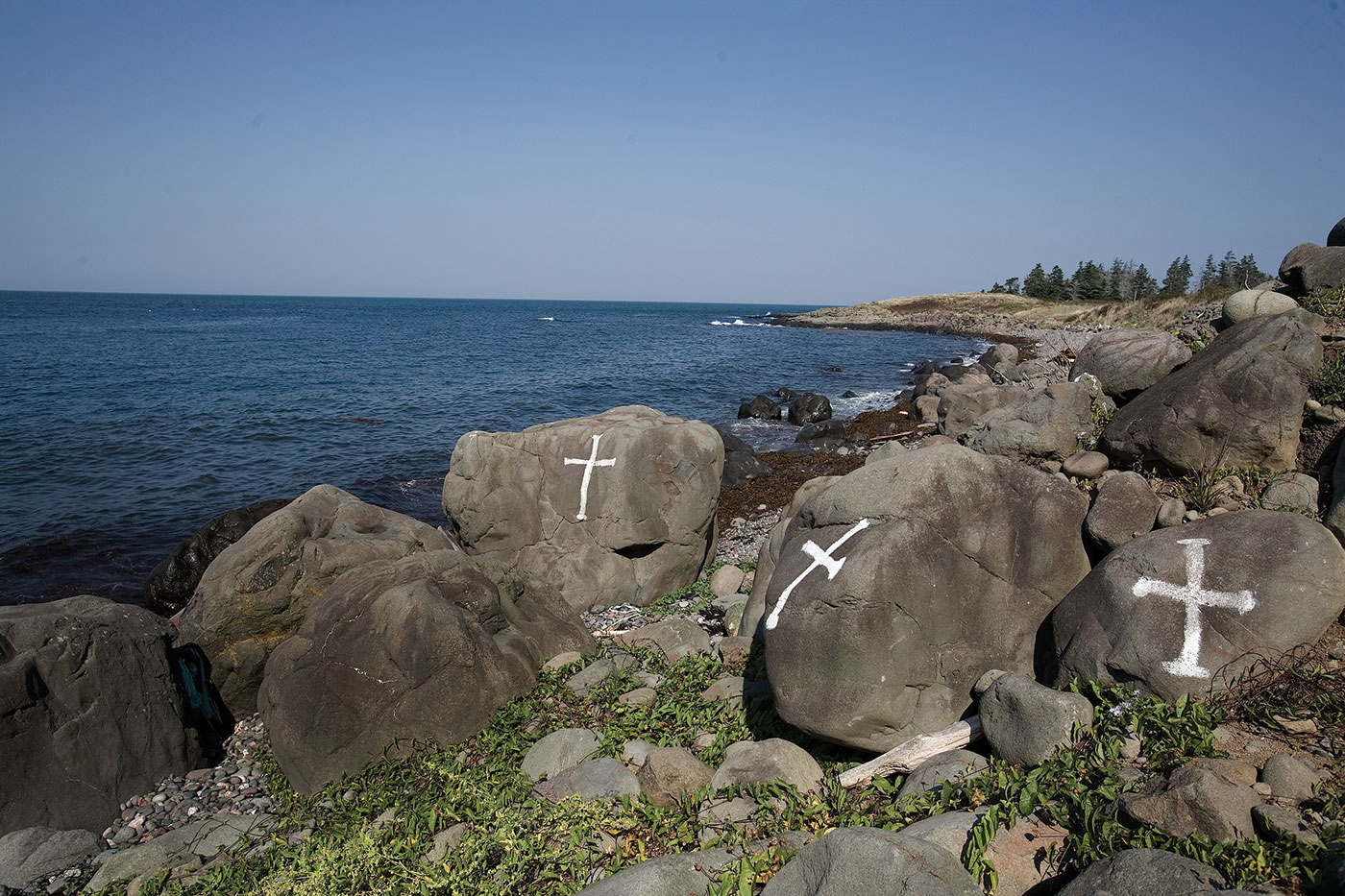
In New Jersey, at Tally-Ho, a roadside restaurant to which the lot of us had repaired, Bill Clayton Sr. watched the passing traffic.
He had brought the company off the family farm to spanking new offices, but he was easing himself out now, as his body still hurt from the early days when he’d shovelled sand into the company mixer himself. Plaques on the boardroom walls attested to the company’s fine concrete and cited its excellent use in various offices and university buildings. Others noted Bill Sr.’s outstanding corporate citizenship. He was big in Boy Scouts.
A couple of trucks drove by, slightly shaking the roadside restaurant. “Lots of sand going north today,” he said.
Joe, the company sales manager, was wearing a short-sleeved shirt. He had strong forearms, a shining bald pate, and a wide grin.
“You’re from Canada,” he said.
“Montreal.”
“They laid 3 million yards of concrete in Montreal last year,” Bill Sr. said. “Don’t know what they’re doing up there.”
“Why don’t you find a gravel pit there, Bill? ” said Joe. “I love that city.”




